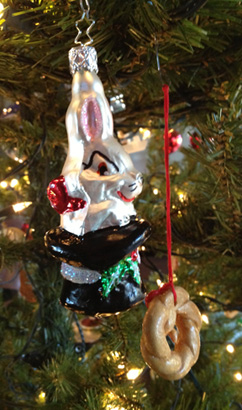
Note ye ed's email address: stevebryant99@gmail.com. Season's Greetings. 
|

Note ye ed's email address: stevebryant99@gmail.com. Season's Greetings. 
|


 The family tree. |
December 2012 Season's Greetings! In a few weeks, on January 2, the Magic Castle will celebrate its 50th anniversary. More specifically, the Castle plans to celebrate all year, and I envy those who get to join in the festivities. I've been a fan and supporter from the get go (though a member for only 45 years), and I wish everyone in Hollywood the best. Under the circumstances, this issue will largely be about Milt Larsen, whose House on Haunted Hill is only part of the Milt Larsen story. Like others of his ilk (I'll discuss four more below), Milt has tried his hand at many things, and he lays out the whole story in My Magical Journey/The First 30,000 Days, an essential autobiography that should top your Christmas wish list. Ten years ago, for the Castle's 40th anniversary, I collaborated with Richard Kaufman on a 34-page article in Genii (January 2003). Genii subscribers are encouraged to revisit those pages online and enjoy the story in lovingly spooky detail. We'll round out the magic musings with a look at the December issue of MAGIC (Milt Larsen hogs the cover) and a new book of Christmas magic, just in the Jolly Old Nick of time. It has again been a bountiful year in magic as well as with family, especially the trips to London and Walt Disney World. I'll close again this year with photos of my grandkids, who make life fun all over again. A very Merry Christmas, or whatever holiday suits your fancy, and Happy New Year to all. |
|
|
THE FAB FIVE -- The regard in which I hold Milt Larsen can be appreciated only in the context of my regard for others like him, creative American geniuses who started small and bet everything they had on their dreams. They saw the things we all would want, things that hadn’t existed before, things that made the 20th century (and now the 21st) the best times ever in which to live. I never tire of hearing their stories, of how they started from scratch, risking all they had personally, in pursuit of their visions. Accordingly, let’s take a look at my Fab Five.
| |
| |
| |
| |
|
|
|
A MAGIC CHRISTMAS ISSUE -- Over the past few months, especially as Genii’s 75th anniversary kicked into high gear, I have neglected any recent mention of its only true rival, Stan Allen’s MAGIC. Partly because Milt is on the cover, which gives me an excuse to post his mug, let me mention that in the December issue Stan knocked several articles out of the park. “Open Sesame” is by Milt himself on how the whole Magic Castle thing got started, and, I'm happy to note, the piece is going to be continued. As I have mentioned above, I never tire of hearing these startup stories. “Road Trip” is Jason England’s account of his and R. Paul Wilson’s cross country “quest for great magic, great food, and a flawless false shuffle” with a most surprising last incident. “Twelve Magical Months” chronicles the 1.7 million dollar give away that Stan will cough up at MAGIC Live to rival the Genii bash gift bag, or so I wish. It’s a crazy month by month list of things you could buy if you were stinking rich, my favorite being Burger and Fryes and Pop (Eugene Burger, Charlie and Sherry Frye, and Whit “Pop” Haydn will come to your house and teach you magic, all for only $7450). Josh Jay’s “Talk About Tricks” lists Josh’s ten favorites from the past year, sending me back through my bookshelf, the delightful find being Jason Dean’s Double Open Prediction. But the really cool thing in Josh’s column is a link to his Bluff Shift Bundle video. I once paid for this download, probably ten bucks, and you can get it free. These bluff controls are fun to do, and the price is so right. You aren’t a MAGIC subscriber? Just buy the issue online for your iPad for only four bucks and you get this ten-buck video gratis. Such a deal! Plus, Ian Rowland offers a surprisingly spooky item, Mark Kornhauser is as first-readable as ever, and so on. You should be a subscriber, so check it out if you aren’t. |
 Stan puts out another great issue. |
|
 Happy holidays! |
IT'S BEGINNING TO LOOK A LOT LIKE CHRISTMAS -- The Magic Castle is always at its most beautiful during the Christmas season. Whether any of this year's December performers (Oscar Munoz, Robert Baxt, Jon Armstrong, Scott Land, Woody Pittman, and Dana Daniels, among others) plan on doing any specifically holiday material I have no idea. However, if they want to do so, they can find many good ideas in a new book, Magic with a Christmas Theme, by Marc Dibowski. Although the book is subtitled Christmassy ideas for (children's) entertainers, there are ideas that will work fine for adults as well, my two favorites being a card matching routine (with Christmas expressions written on them) and the prediction of a date chosen from an Advent calendar. Whether you choose to do an entire Christmas-themed act or merely insert a Christmas routine into your regular program, you should find plenty from which to choose. Mr. Dibowski is an elementary teacher in a large town in Germany and performs semi-pro for both children and adults. His book in excellent English covers the entire spread of Christmas magic, including music, stage setting, props, traditions around the world (I learned a lot about Christmas I didn't know), gags, routines, fragments of routines, and practical thoughts on producing Santa Claus. I was going to say that Christmas magic isn't quite my thing (I'm more Halloween), but I must stand corrected. A spirit slate routine (that has nothing to do with messages from beyond) in the book is compelling, and I'd love to perform it at my next opportunity, regardless of the season. Seventy-eight pages, foreword by David Kaye, available from http://www.md-magicbooks.com/ as an e-book or printed edition, $25. |
|
At Christmas once again, we indulge in a family visit ...  One grandkid likes her blue coat, the other plays the blues. Peace on earth, good will to men.
Little Egypt Magic is the erratically updated web site of Steve Bryant, spawned (the site, not Steve) by a former internet magazine known as The Little Egypt Gazette/for magicians only. Steve Bryant is an obscure magician and writer who generates this site from an iMac in Bloomington, Indiana. He frequently journeys to and performs magic in Little Egypt, the local name for extreme southern Illinois, where the towns bear such names as Cairo, Thebes, and Karnak. Past issues of this web site: Index to Past Issues Notice: Any limited use of copyrighted images or quoted text is considered fair use, usually to review whatever product or event that is under discussion. If you object to use of any material, please get in touch and it will be cheerfully removed. |
A JSB Creations product
Copyright© 2012 by Steve Bryant